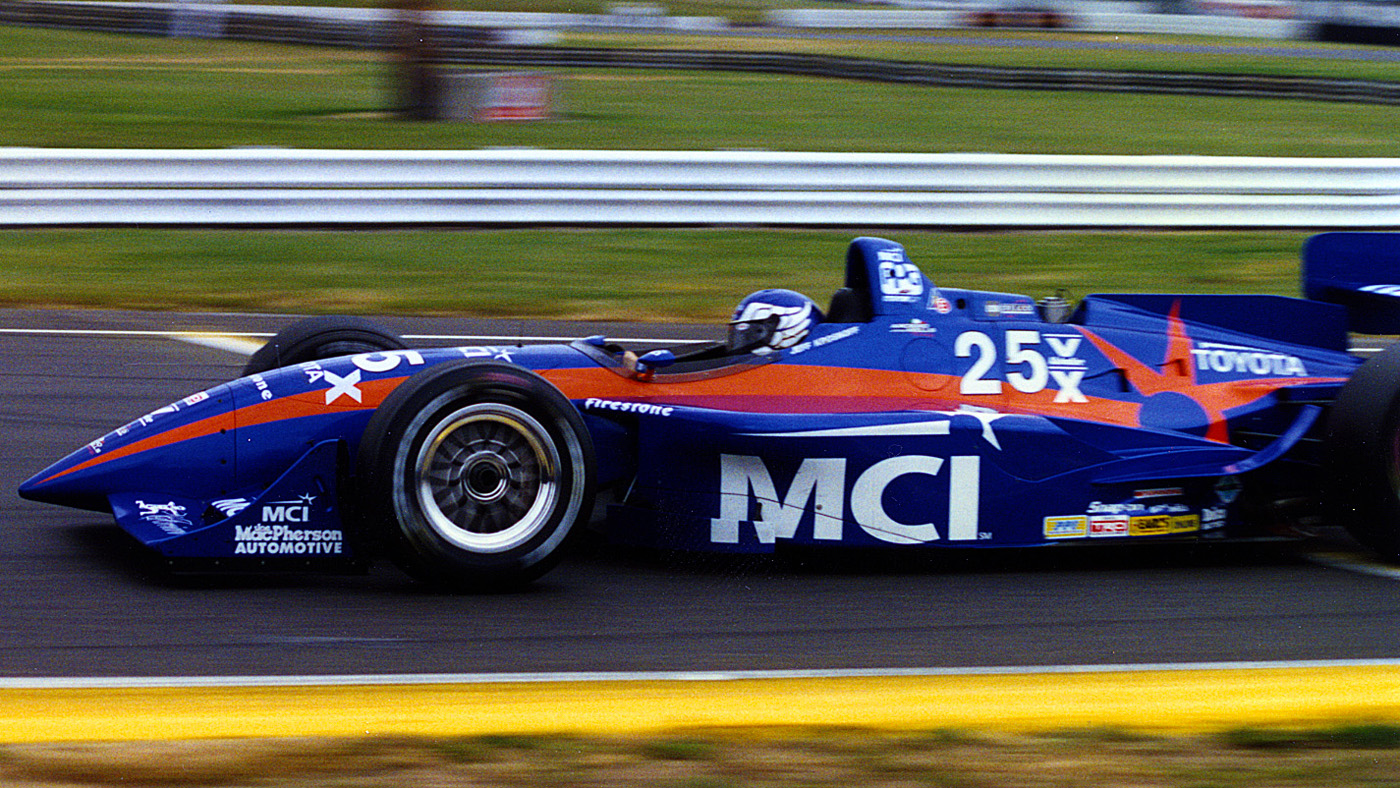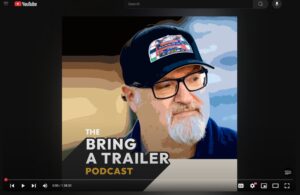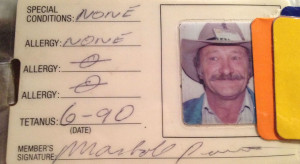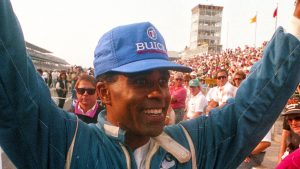Back in 2011, a lot of amazing people helped me to celebrated the life of Jeff Krosnoff, the American IndyCar driver who was killed at the Molson Indy Toronto race on July 14, 1996. That six-part legacy series originally ran on the former SPEED.com site, and with the 20-year anniversary of Jeff’s death upon us, I’ve gone through and done a fresh edit on the Jeff Krosnoff: Stay Hungry series.
Start with Part 1, Part 2, and Part 3, then follow with Part 4 below.
“Jeff’s been in a wreck. Bob Sprow was on his radio for that, he spools up the radio and we get nothing back.”
~ Cal Wells, Krosnoff’s IndyCar team owner
In Part 3 of Jeff Krosnoff, Stay Hungry, we left after Jeff had completed Round 10 of the 1996 CART IndyCar championship at Cleveland and optimism was high within the Arciero-Wells camp as the Molson Indy Toronto event approached.

Toyota’s first season of CART competition hadn’t gone well; from a lack of power to poor reliability, the gap to established manufacturers like Ford, Honda, and Mercedes was significant, but the men at Toyota Racing Development (TRD) came up with a few new tricks for its Toronto engines.
The 2.65-liter turbocharged Toyota ‘RV8A’ was beginning to show the first signs of potential after Krosnoff finished three of the four races prior to the Canada trip, and with TRD starting to get a handle on durability, the Torrance, California-based firm pushed the boundaries even more for the upcoming race in downtown Toronto.
Krosnoff’s Reynard-Toyota, like the two Toyota-powered entries from All American Racers for Juan Fangio II and PJ Jones, would have a higher rev limit to use at Toronto, but the Toyota’s season-long top speed deficiency remained. The extra RPM helped slightly, but it was a change to the engine mapping that would make the biggest difference.
With Toronto’s numerous slow corners, TRD concentrated heavily on giving the RV8A better low-end torque and throttle response to help launch its cars between turns, and in particular, out of Turn 1 onto the long Lake Shore Blvd straight.
The Toronto race was about to follow a similar theme for the American rookie. Starting towards the back of the field at every event meant Krosnoff received very little airtime and recognition during his first 10 CART races, but even as a driver mired deep in the pack, a few traits stood out.

Krosnoff was smart—obsessively so—and brought every ounce of his intelligence to perfecting the setup on his cars. Jeff’s most demonstrative attribute, the one authored from the cockpit of the No. 25 car, earned rave reviews from his colleagues.
Attacking—whether it was for a spot on the podium or for last place—was Krosnoff’s style, and it wasn’t applied through reckless measures. With just one race-ending crash through the first 10 events, Krosnoff distinguished himself as rookie who was fast and made very few mistakes.
He’d been saddled with uncompetitive F3000 cars many times while in Japan, but Krosnoff never relented, never dialed his efforts back to match the car’s capabilities. It wasn’t all or nothing with Krosnoff–just lots of all, and for 1996, that mindset was required to make forward progress in CART.
Although few were aware or had reason to notice, Krosnoff’s odds of earning another solid finish were slightly improved with the up-rated RV8A at Toronto. It wasn’t a case of having a front-running engine, but with the Toyota’s extra torque and more aggressive mapping, Jeff was able to deliver his best qualifying position of the year with 20th on the 28-car grid.
Granted, it was still well off of Andre Ribeiro’s pole time of 58.060 set in the Tasman Motorsports Lola-Honda, but Krosnoff’s lap of 59.779 easily led the Toyota contingent.
Krosnoff’s Reynard 96i, wearing the distinctive blue MCI livery, squirmed and fought to break loose as he kept the car dancing on the edge of adhesion in the corners, and with 95 laps around the 1.75-mile, 11-turn circuit on tap for the race, he was primed for another virtuoso drive far removed from the spotlight.
Working his way through the field, Krosnoff found himself dicing for 15th place in the latter stages of the race. Krosnoff was sitting in 16th when Michael Andretti brought out a yellow after his engine expired on Lap 84. Once Krosnoff inherited 15th from Andretti, it was time to make the restart count to move closer to the top 10.

With Emerson Fittipaldi directly ahead, and Stefan Johansson directly behind, Krosnoff was surrounded by drivers with the stronger Ilmor-built Mercedes motors, faced engine deficiencies in every area, and knew holding 15th would be a major challenge on the long run down to Turn 3.
The green flag flew with six laps left to go and, as expected, Johansson motored past to take the position. Krosnoff was determined to get it back the following lap and rocketed off of Turn 2 to attempt a slipstream pass.
Shooting down Lake Shore Boulevard at speeds reaching 175 mph, Fittipaldi led Johansson who was in his wheel tracks, Krosnoff, and Gil de Ferran as they approached the crossover bridge just prior to the braking zone for Turn 3. Krosnoff had already pulled out and to the right to set Johansson up for an inside pass at the end of the straight, and had made a little bit of progress by nosing ahead of the Swede’s right-rear wheel.
Johansson, still following directly behind Fittipaldi and unaware Krosnoff was trying to recapture 15th, had visions of making the same kind of swing-to-the-right pass on Fittipaldi, and started the maneuver.
“It just presented itself then,” Johansson said. “I mean, obviously, you see the opportunity and you go for it. So, it’s just one of those situations. It’s not… to be honest, I don’t even recall the laps before, exactly what happened and how it happened, but, I mean, when you see there’s an opportunity you go for the gap, and that’s exactly what I did. I had, obviously, no idea that Jeff was coming hammers and tongs on the inside.”

With Johansson’s right-rear tire thrust into Jeff’s left-front, the rubber-to-rubber meeting lifted the front of Krosnoff’s car off the ground and broke his left-front suspension, which folded over across the chassis and almost touched the right-front suspension. Jeff was in trouble, but his fate wasn’t sealed until his left rear tire followed and rode over Johansson’s right-rear.
The final contact with Johansson’s left-rear served to launch the rest of Jeff’s car into the air where it rotated off its right rear tire—the only corner that was left touching the ground before it took flight.
Krosnoff’s car was nose-up, turning hard to the right in midair at unabated speed. It seems unfathomable today, but the catch fencing along Lake Shore in 1996 actually sat behind the corner workers, and acted as more of a barrier to protect fans sitting on the grass than the workers and photographers who navigated the trackside footpath.
More importantly, it meant Gary Avrin and the rest of the corner workers were exposed to anything that came over the waist-high cement barriers.
Captured on the ABC broadcast, the Turn 3 TV camera pointing at the cars coming into the corner showed the underside of Krosnoff’s Reynard growing larger in the frame. The surreal visuals—of an Indy car coming at the camera floor-first—coincided with the Reynard rotating to the right side of the track on a trajectory for the cluster of volunteer workers.
44-year-old Avrin, a graduate of the University of Toronto who spoke six languages, was struck in the head by Krosnoff’s car and killed instantly. Michigan’s Barbara Johnston, who was stationed alongside Avrin, was fortunate to escape with lacerations to her head.

With momentum carrying his car into the fence behind the workers, the nose of the Reynard dug in and Krosnoff began pirouetting through the air. It was as if something lifted the Reynard up about six feet off the track, flipped it on its side so Jeff’s helmet was facing the right side fence, and sent the car tumbling nose after tail down that fence at 150 mph or more.
Krosnoff was fortunate to miss hitting the bridge during the vertical barrel roll, but with so much speed and energy still involved, the next gyration slammed the top of the Reynard chassis and the driver it carried head first into a tree with immense force. It was a chance meeting–the proverbial one-in-a-million shot.
The car continued its crash along the fence and exploded like a bomb after hitting a steel light pole—another exposed item that wasn’t behind the fence. Although the beefy Reynard chassis withstood a lot of the damage against the tree, the destructive impact against the pole broke the front of the chassis away from the cockpit which left Jeff’s legs exposed.
Only the front of the Reynard made contact with the pole, but the brute force of the strike was powerful enough to shear the back of the car off at the bulkhead. It sent the engine and transmission tumbling down the track and into the runoff area along with the damaged cars of Johansson, Fittipaldi and Andre Ribeiro.
Coming to a rest on the left side of the track, Krosnoff sat motionless in the remnants of the Reynard tub as a team of six CART safety and medical response personnel immediately descended upon the scene.
At the same time, the Arciero-Wells team was also trying to get a handle on the severity of the situation.

“Jeff’s been in a wreck,” Krosnoff’s team owner Cal Wells said as he recalled the communication exchange on pit lane. “Bob Sprow was on his radio for that, he spools up the radio, and we get nothing back. The first replay showed (Ribeiro) down the runoff area; we just didn’t see Jeff down there. Then, when we saw the other replay we knew, s***, this is bad.”
What Wells and the rest of the team then heard over CART’s radio channel brought everyone inside the horror of what the safety team found in Turn 3.
“And then you hear them call out a Code 5,” Wells said. “Code 5 is death.”
Wells didn’t know there were multiple injuries at the crash site, and assumed the Code 5 was in reference to Jeff as the safety team continued to work on Krosnoff while he was strapped into the car. Unfortunately, a few hundred feet up the track from the shattered Reynard, there was no need for a similar sense of urgency.
Without going into an unnecessary level of detail, the focus of the safety team fell on Krosnoff for a reason. Despite suffering broken bones in his lower extremities, Jeff was still in one piece. Emergency responders only needed one look at Gary Avrin to realize he was beyond medical care.
“Both of them were killed instantly,” Wells said. “Now, Gary maybe a millisecond before, but there wasn’t two more tumbles and Jeff was into that tree. They were seeing each other on their way to heaven. One could rope ladder up to the other. It was that close.”
As the sorrowful scene at Turn 3 was unfolding, CART officials kept the field circulating until the event was halted and cars were stopped just past Turn 2 on Lap 93. Adrian Fernandez, who was leading when the yellow came out, was awarded his first CART win.
The respected Mexican driver and his Tasman Motorsports Group were overjoyed to earn their first win together, and with Krosnoff’s plight largely unknown outside of the crash site, the team celebrated just as one might expect on such a momentous occasion. It was also Lola’s 100th Indy car win and the first victory for a female engineer in the series–Tasman’s Diane Holl.

But with the realities of Turn 3 beginning to set in for some teams like Arciero-Wells that had heard the Code 5, the jumping and shouting by Fernandez and his crew came across as cold and callous. In reality, the team knew it was a bad crash, but the news of two fatalities had yet to make the rounds throughout the paddock.
“No, we didn’t know; and the other side, it was my first victory,” Fernandez said. “So the two compounded and we didn’t get any news so we thought he was fine. Right after the celebration, right after the press conference, that’s when we found out. So when I pulled into Victory Lane, it was hard to forget about your emotions when you don’t know really what happened to Jeff and knowing it’s your first win.”
In a sad twist of fate, Fernandez would have another victory overshadowed by death–the 1999 CART season finale at Fontana where Greg Moore was killed.
“It was different than Toronto when I won in the Fontana race,” he continued. “As soon as I came into the pits, the first thing my PR guy Kevin Diamond told me was Greg Moore has passed away. And it was a shock. I couldn’t celebrate, I was crying, he was a good friend of mine, obviously, I knew him a lot more than I knew Jeff, and obviously there was no celebrations or nothing because straight away we knew. I remember I went to the bathroom and I started crying because it just doesn’t happen that often and it came as a shock to me. I have very mixed feelings with this happening twice in my career.”
With the race now over, Wells rushed to Turn 3. He was jarred by the severity of the accident and recognized the immediate need to transport Jeff from the streets of Toronto to a proper hospital. That sense of urgency, however, had nothing to do with saving Krosnoff’s life.

To his dismay, the situation was quickly turning from one of emergency response to a police state as the Toronto authorities wanted to lock down the entire crash site with Jeff stuck in the middle of a sprawling accident investigation.
Thinking quickly, Wells–along with the CART safety team–hastened a retreat to the hospital with Krosnoff to ensure his driver and his driver’s family would not get caught in the procedural complications that were brewing.
Wells’ urgency to extricate Krosnoff from Turn 3 while emergency medical procedures were being administered drew a lot of criticism at the time, but he dismisses the notion that anything could have been done to save his driver at the track or any other location.
“Well, the fence was right up against a tree and that’s what his head hit,” he said. “So his head hit the tree and…that was it. All the other stuff people said about what caused the fatality, that he was all busted up and that’s what did it…all the other horses***…it was his head was hitting the tree.”
Wells was also less than impressed by the theatrics that played out when he and Jeff’s wife Tracy arrived at the Toronto Western Hospital.
“When we started following him to the hospital–Tracy was with me—the ambulance just wasn’t in a hurry,” he said. “And then when they took him out, they must have seen she and I were there, and they tried to fake like they could bring him back, blowing air into his lungs and boy, it just started pumping blood all over. I would not let her look at it and I was blocking it. She was saying, ‘I’ve got to see it,’ and I said, ‘No, you don’t.’ He didn’t look the best. His legs were going the wrong way, and you just knew it. Tracy didn’t. She didn’t want to believe it.”
At 4:20 p.m. ET, shortly after their arrival, Jeffrey John Krosnoff was pronounced dead.
“It’s one of those painful things where the doctor comes in the room and the family’s there and they say, ‘Sorry, we’ve lost him,’” Wells added. “And Tracy collapses…and his mom and dad were there. It’s just as bad as you can possibly think. You just can’t get any worse. So, you just deal with it because you can’t do anything about it.”
In the immediate aftermath of what took place, Johansson was blamed for the accident by some and still bears the scars from what took place so long ago in Toronto.

“I knew Jeff quite well, actually, because we raced a lot in Japan together,” he said. “It’s just all a horrible, bad memory. It’s one of those things; it was just a very unfortunate racing accident, where everything that could go wrong went wrong at the same time. The place where it happened, the speed that it happened, the amount of cars that were in one place at the same time, and it was just one of those things. Just a bad, bad, bad situation.”
Fatalities were nothing new in open-wheel racing in America, and despite the sad outcomes, those events tend to be handled in a swift and orderly fashion with the local authorities. But with this accident taking place outside of the U.S., all involved would soon learn the Canadian police had a different plan on how it would be managed.
Rather than treat the deaths of Krosnoff and Avrin as unfortunate outcomes from a risky sporting event, the local municipality viewed the accident and the ensuing fatalities as events that had assignable causes. Who was at fault? Who needed to be charged?
As an aside, I recall walking down towards Turn 3 hours after the race because the parking lot for teams was located just outside the corner. We’d arrive each morning long before activities started, as did most teams, and it was normal to come in through Turn 3 and to leave through the same corner at the end of the day. When we got there Sunday evening, the entire area was still blocked off with yellow police tape. It was quite eerie.
All of the damaged Indy cars and broken components were stationary as the Toronto police treated the section of the track like a crime scene—like a homicide had taken place and all of the evidence needed to be processed by detectives to build their case. Along with a few other teams that arrived around the same time, we got creative and found another way out, but the sight of accident, protected and preserved within the yellow tape, left our team speechless.
What came next in Canada took a page from Ayrton Senna’s high-profile death at the Imola circuit in 1994 where his car was impounded and key figures from his team faced a variety of legal risks during the macabre proceedings. A year-long legal fight commenced that only served to compound the suffering felt by the Krosnoffs, the Arciero-Wells team, and the CART community as a whole.
Despite the collective need to grieve and mourn in the aftermath of Toronto, the wound would remain open for years to come.
Coming up in Part 5: Dramas, farewells, and pivoting to the future.




